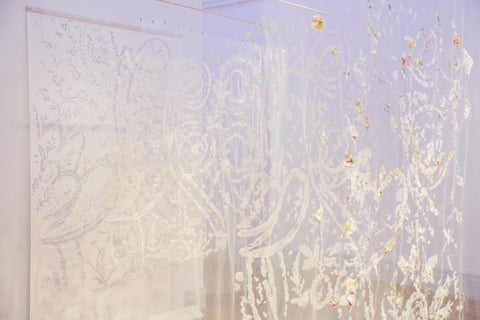Artist Spotlight: Mona Craven tells us what Indian and Scottish embroidery have in common

Mona Craven’s Whitework, An Unravelling wants you to move around it, breath in its many layers, get as close as you dare to examine its swirls of embroidered detail.
It is an imagining of a section of cloth blown up to a large scale and deconstructed so you can physically stand within the layers of history that formed the art of whitework, and to connect with the people who would have constructed the cloth.
Craven, a fine-art textile practitioner, educator and researcher, talked to us about her work:
Your piece is a deconstruction of whitework; can you tell us more about the technique and why you have chosen it as your subject?
The work forms part of practice-based research for a PhD in textile culture.
The installation involved a conceptual unravelling of a cloth embroidered in 1860s India, which is also a christening gown. It depicts a hybrid version of the white-on-white nineteenth-century ‘Chikankari’ and ‘Ayrshire’ embroidery styles.
Researching the surface in hands-on ways allowed me to think about what might be involved in making such a cloth. During the mid to late nineteenth century, whitework was produced in Ayrshire, Scotland. Here, techniques, design and working conditions share similarities but also differ from those of Chikankari, produced in Lucknow and Calcutta (Kolkata), India, for Moghul patrons. A less finely embroidered version was created for export to Britain and its colonies. In both places, the work was arduous and poorly remunerated.
Relying on digital technology to reproduce the surface, I deconstructed the cloth, creating a new surface big enough to fit a former Victorian import house's window. Reworking the design involved drawing for days on end while I was thinking about how such a finely embroidered muslin cloth was made. How many people worked to stitch the stretched cloth surface? What were their stories?
From this starting point, using silk-screening and embroidery techniques, I created other layers reflecting on the histories of the landscapes associated with the cloth. Printing randomly selected text from a book on Empire and images from a botanical source, my work involved attempting to wash off glued-on stories. What remains are the scrunched, textual, flowerlike shapes, re-embroidered whilst thinking about what remains to be unravelled.

Image: Alastair Brookes/KoLAB Studios
You describe your experience of living in South Africa as informing your work. Can you tell us more about that?
I grew up and studied Fine Art and printmaking in a place where fauna and flora have evolved to be resilient, the Eastern Cape, South Africa. It is also a former eastern ‘frontier’ region of Britain's Cape colony, where conflict between the Xhosa and the British was ongoing for decades. British people were selected by the Colonial governing authorities to settle and strengthen British influence in the colony; a first tranche landed in Algoa Bay, now known as Nelson Mandela Bay, in 1820. These settlers established farming communities, smaller towns, and a regional capital, Grahamstown, now known as Makhanda, and the port of Port Elizabeth, now Gqeberha.
The region was the site of ongoing wars for nearly a century. It also became known for its fine wool exported to Britain from the 1830s onward. During apartheid, the region was both a site of conflict and where cultural expression crossed divisions. The history of this place, its geography and people influence my understanding. This was where many others and I learnt to draw, etch and see beyond the surface.
It is possible to physically stand inside your piece and look through the stitching into the gallery and deeper in the artwork itself - what do you hope people will see?
The installation was first presented at Shifthink, Art Textiles in the Provincial, 2020, in a former Victorian Institute. Here, the positioning of the installation involved thinking about how the visitor encounters the space between the cloths. I projected light onto the installation. Being present, I could see a community using its building and observe how visitors engaged in the space between the cloth layers. As a result, I realised shadows, and the building and its stories of the past and present and those of visitors were in conversation with the work.
Walking past the work, a visual movement occurs, bringing an interactive, unpredictable element into play.
It is my hope that my work, as seen at Soft Power, stimulates a visitor to think about their stories and presence within the space and about other work seen from within the installation. The bigger conversation includes seeing the embroidery by Ellen Sharples and listening to conversations occurring between other works, the RWA building and its stories. A space holding an interconnectedness.

Image: Alastair Brookes/KoLAB Studios
You can see Whitework, An Unravelling in Soft Power: Lives told through textile art until 10 August 2025.
Annual Art Pass: £18
Day ticket: £9.90 (inc. Donation)
Concessions: £5.45 (inc. Donation)
Students and under 18s: Free